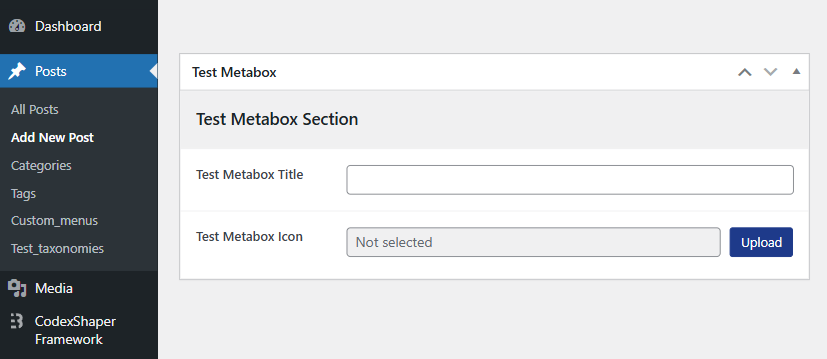Custom Metabox
1. Using Option Builder
A powerful Option Builder allows easy creation of Metaboxes.
Example: Creating portfolio-option metabox for portfolio post type.
php
$prefix = 'cmf_metabox';
Metabox::create(
$prefix . '_portfolio_options',
array(
'title' => esc_html__( 'Portfolio Options', 'textdomain' ),
'post_type' => 'portfolio',
)
);
Section::create(
$prefix . '_portfolio_options',
array(
'title' => esc_html__( 'Portfolio Info', 'textdomain' ),
'fields' => array(
array(
'id' => 'portfolio_title',
'type' => 'text',
'title' => esc_html__( 'Portfolio Title', 'textdomain' ),
),
array(
'id' => 'portfolio_thumbnail',
'type' => 'media',
'title' => esc_html__( 'Portfolio Thumbnail', 'textdomain' ),
),
),
)
);Arguments
| Name | Type | Default | Description |
|---|---|---|---|
title | string | - | The label that appears above the field. |
post_type | array|string | post | Specify one or more post types where the metabox should appear. |
fields | array | - | Specify one or more fields for the metabox. |
id | string | - | Identifier for the field. |
type | string | text | Field type. |
2. Creating Manually
Steps:
- Navigate to:sh
{project_root}/wp-content/plugins/codexshaper-framework/src/Metaboxes - Create a file using
UpperCamelCase.phpnaming convention (e.g.,TestMetabox.php). - Open the file in a text editor and insert the following code:
php
<?php
namespace CodexShaper\Framework\MetaBoxes;
use CodexShaper\Framework\Foundation\MetaBox;
if ( ! defined( 'ABSPATH' ) ) {
exit; // Exit if accessed directly.
}
class TestMetabox extends MetaBox
{
public function __construct() {
// Do your settings here
parent::__construct();
}
public function get_id() {
return 'cmf_test_metabox';
}
public function get_title() {
return 'Test Metabox';
}
public function get_screen() {
return array( 'post' );
}
public function register_sections() {
$this->add_section([
'title' => esc_html__('Test Metabox Section', 'textdomain'),
'fields' => array(
array(
'id' => 'test_metabox_title',
'type' => 'text',
'title' => esc_html__( 'Test Metabox Title', 'textdomain' ),
),
array(
'id' => 'test_metabox_icon',
'type' => 'media',
'title' => esc_html__( 'Test Metabox Icon', 'textdomain' ),
),
),
]);
}
}You should see your new Test Metabox with the Sections and Fields you created.
